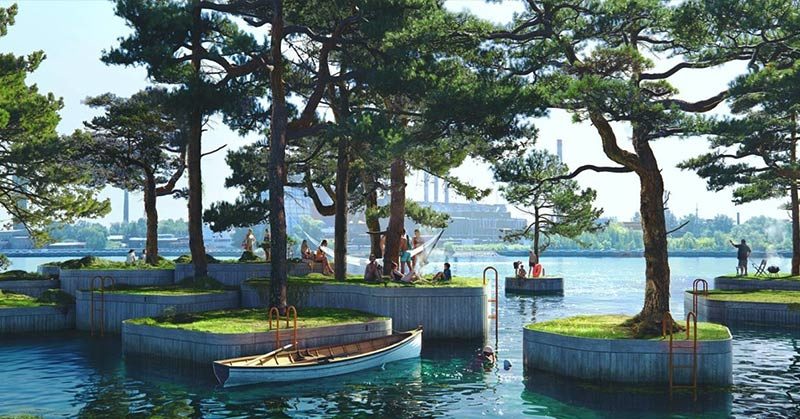The benefits of being outdoors have become increasingly evident over the last several years. Getting outside helps you get more exercise and vitamin D, helps ease anxiety, encourages social behavior, and improves your sleep, self-esteem, focus, immune system, and creativity [1].
Because of this, city planners are looking for ways to increase access to outdoor green spaces in communities, particularly for those who live in urban centers. In large cities around the world, however, their biggest issue is a lack of space.
A non-profit organization in Copenhagen, Denmark, has found a creative way to maximize their city’s space by creating floating islands, where citizens can kick back and enjoy the outdoors.
Read: Levi’s Found a Way to Make Hemp Feel like Cotton
Floating Islands- A New Place to Explore
Copenhagen’s new floating islands were designed by Australian architect Marshal Blecher in partnership with Danish design studio Fokstrot. They have unveiled plans for a “parkipelago” of floating islands, which they’re calling the Copenhagen Islands, that city residents and visitors can use for free [2].
Created as a way to take advantage of underutilized, nearly forgotten parts of the city’s old harbor, these new mobile islands will not only benefit citizens of Copenhagen but will create natural green spaces that benefit both plants and animals.
Each island will be built by hand using traditional techniques in the boat-building yards in the city’s south harbor. The first prototype, CPH-Ø1, is a 215-square-foot platform made of timber and features a Linden tree in the center. It is buoyed by recycled plastic water bottles and serves as a resting spot for residents enjoying water activities like kayaking, as well as a small event space [3].
The CPH-Ø1 was launched in 2018 to great success. The island’s website describes it as a new form of greenspace for the public:
“By placing it on the water, it creates immediate wonder for people, passing by. This is the first taste of a completely new type of public space coming to Copenhagen. Moveable, floating, public spaces free for people to explore and conquer” [4].
Since they are moveable, the islands can be easily adapted to meet the needs of the public. During the summer, they can be spread out in designated areas for boaters, swimmers, and kayakers to use, but can also be tethered together to create one large island that can be more easily accessed by land [5].
The website says that the islands will be placed in suitable locations around the inner harbour, but will also be put in underused corners of the harbour to bring back life to that area.
“Hopefully giving back a little bit of space for whimsy and wonder to the old industrial harbor sides.” [4]
Read: First Floating Ocean Hybrid Platform Can Generate Power From Waves, Wind And Solar
Good for the People, Good for the Planet
Copenhagen’s floating islands provide a brand new type of sustainable outdoor public space. All of the trees, plants, and grasses that are grown on top of each island will be native to the area, creating a habitat for birds and insects.
The space underneath each island will provide ideal growing conditions for seaweed, and create a hospitable environment for sea creatures like fish and mollusks.
The architects explained that the islands reintroduce “wilderness and whimsy” to the harbor and offer a constantly changing, sizable greenspace in the heart of the city.
“The project also hints at a new type of climate resilient urbanism, inherently flexible in its use and only using sustainably sourced and recycled materials.” [2]
The project has received two awards for excellence in design, including the Taipei International Design Awards for Public Space as well as the award for Social Design [2].
Read: Find your inner Tarzan by sleeping in the trees in these awesome raindrop-shaped tents
CPH-Ø1 is Only the Beginning
The plan is to ultimately have nine islands in total, each one of them unique and built for a different purpose. Each island will serve as a space for different activities, like swimming, floating gardens, a floating sauna, a sail-in cafe, and a mussel farm [4].
Because these islands are made to be flexible with the local environment, they can be built in other harbour cities as well. For crowded cities that have a lack of greenspace, floating islands could be the answer to their problems.
Keep Reading: Austin Is Getting a Village of 3D-Printed Affordable Homes—and They Look Incredible
- https://www.webmd.com/balance/ss/slideshow-health-benefits-nature
- https://inhabitat.com/floating-islands-bring-a-new-type-of-public-park-to-copenhagen/
- https://inhabitat.com/this-hand-built-island-is-the-start-of-copenhagens-parkipelago-of-floating-public-spaces/
- https://www.copenhagenislands.com/about
- https://www.travelandleisure.com/attractions/parks-gardens/floating-park-copenhagen-islands-denmark#:~:text=Marshall%20Blecher%2C%20Studio%20Fokstrot%2C,public%20to%20enjoy%20the%20outdoors

